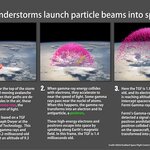Atmospheric

Sure, Los Angeles has a terrible smog issue but it could be worse; movie stars could live on Titan. Titan, Saturn's largest moon, looks like a dirty orange ball but the actual composition is more like crude oil without the sulfur. Titan's haze is made of tiny droplets of hydrocarbons with other, more noxious chemicals mixed in.
But as nasty as that sounds, Titan is the only moon in our solar system with an atmosphere worthy of a planet at all. At least it has lightning, drizzle and occasionally a big, summer-downpour style of cloud made of methane or ethane,…

The Fermi Gamma-ray Space Telescope has detected beams of antimatter launched by thunderstorms, which act like enormous particle accelerators and can emit gamma-ray flashes called TGFs - and also high-energy electrons and positrons. TGFs are produced inside thunderstorms and shown to be associated with lightning. It is estimated that about 500 such flashes occur daily worldwide, but most go undetected.
Scientists now think that most TGFs produce particle beams and antimatter.
The Fermi spacecraft is designed to monitor gamma rays, the highest energy form of light.…

Oh no, not again. When I was young the buzz was about the coming Ice Age - and it was common sense. Since 90,000 out of every 100,000 years of human history have been Ice Ages and it's been 12,000 years since the last one, logically we have been overdue.
But simple physics says that when you add more people and more pollution to a finite space things will get warmer so warming is a lot more likely than cooling.
Not so, says a writer in the Daily Telegraph, who instead sides with meteorologist Piers Corbyn because Corbyn said it would not be a mild winter, contrary to the Met…

The Bering Sea, northward extension of the Pacific Ocean between Siberia and Alaska, was ice-free and full of life during the last major warm period, a new study has shown.
Deep sediment cores retrieved from the Bering Sea floor indicate that the region was ice-free all year and biological productivity was high during the last major warm period in Earth's climate history. Carbon dioxide levels during the Pliocene Warm Period were also comparable to levels today and average temperatures were a few degrees higher. Climate scientists are interested in what this period may tell us…

The atmosphere is a complex system and therefore the exact amount of warming due to greenhouse gases is the subject of scientific debate but it is proven science that clouds amplify the warming effect and a new model provides more insight into specifics, though some prominent climate skeptics have recently been arguing that clouds would act to stabilize the climate, thereby preventing greenhouse gases from causing significant warming.
Andrew Dessler, a professor in the Department of Atmospheric Sciences at Texas A&M University, says that warming due to increases in greenhouse gases will…
In Europe and worldwide the public attention to environmental protection is growing, together with research of new technologies and new solutions to reduce pollution sources, also in the field of energy and mobility.
However governments and public authorities often establish laws to improve the environment conditions, promising great results, without taking the trouble to provide and manage their actual effects, which in some cases even become the opposite of those expected.
The failure of the Italian government deserves to be mentioned as a glaring example, that in accordance with the…

WASP-12b, a 'hot Jupiter' (Jupiter-sized, extremely hot exoplanet) about 1.4 times the mass of Jupiter and located about 1,200 light years away from Earth, has a carbon-to-oxygen ratio greater than one, according to new measurements.
That makes WASP-12b the first-ever planetary atmosphere that is substantially enriched in carbon along with being the hottest known planet in the Milky Way galaxy.
The researchers contend this carbon-rich atmosphere supports the possibility that rocky exoplanets could be composed of pure carbon rocks like diamond or graphite rather than the silica-based…

A new study says that exposure to polluted air in young mice led to an accumulation of abdominal fat and insulin resistance even if they ate a normal diet.
The U.S. Environmental Protection Agency(EPA) says that nearly one out of every three people in the United States is at a higher risk of experiencing health effects related to the presence of polluted air. Because of the tiny size of fine-particulate air pollution - 2.5 micrometers or smaller in diameter, or about 1/30th of the average width of a human hair - pollutants could reach deep areas of the lungs and other…

Astrobiology researchers say a new discovery may have expanded the definition of life. Conducting tests in the harsh environment of Mono Lake in California, they have discovered the first known microorganism on Earth able to thrive and reproduce using the toxic chemical arsenic, substituting arsenic for phosphorus in its cell components.
Carbon, hydrogen, nitrogen, oxygen, phosphorus and sulfur are the six basic building blocks of all known forms of life on Earth. Phosphorus is part of the chemical backbone of DNA and RNA, the structures that carry genetic instructions for life,…

Climatology might replace economics as the 'gloomy science'. Projections that the lousy economy might mean a slowdown in fossil fuels were cause for joy among activists, without realizing that people without jobs or food or houses aren't as concerned about abstract things like the future of the planet.
Whether or not global warming is a fashionable media topic in 2010, global carbon dioxide (CO2) emissions, the main contributor to man-made global warming, show no sign of lessening and could still reach a new record this year, according to a study that is part of the annual carbon budget…